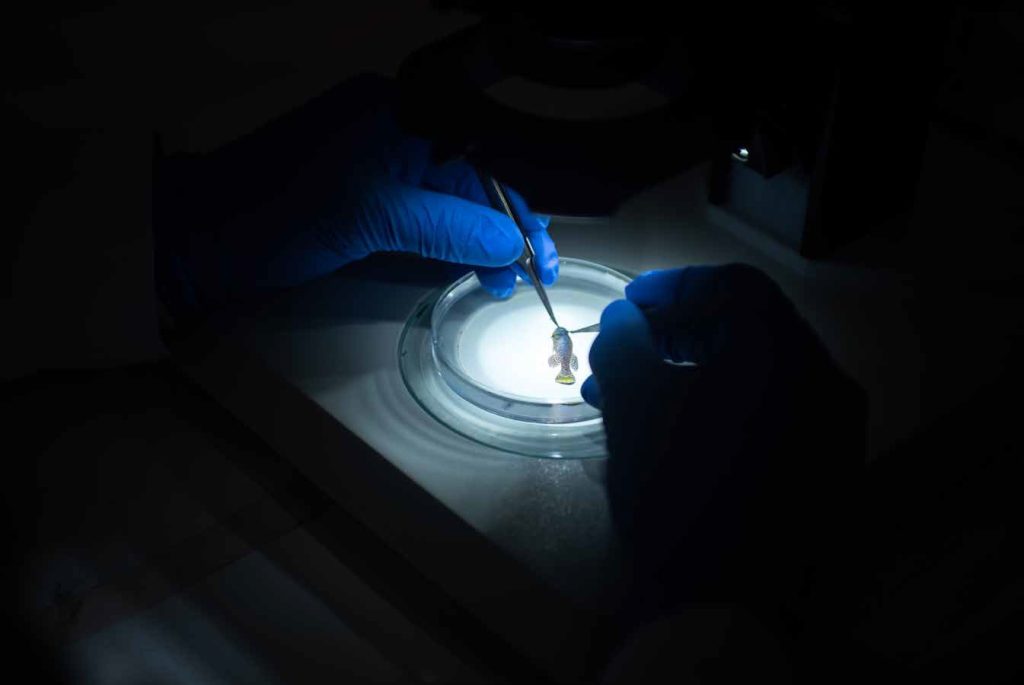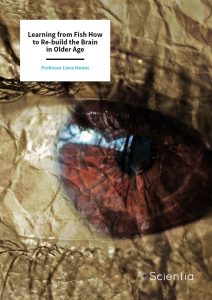Professor Lieve Moons | Learning from Fish How to Re-build the Brain in Older Age
Worldwide, people are living longer lives. One outcome of this is that the prevalence of neurodegenerative diseases whereby the cells in the brain stop working or even die, is also increasing. Based in KU Leuven’s Department of Biology, Belgium, Professor Lieve Moons has been working to better understand how the central nervous system can regrow and repair, with a particular focus on ageing. Her work has important implications for identifying new therapeutic targets for neurorepair in elderly humans.
Neurodegeneration: An Increasing Burden
Neurodegenerative diseases, including those leading to dementia such as Alzheimer’s disease, affect millions of people worldwide. Neurodegenerative diseases are progressive, meaning that they worsen over time and spontaneous recovery does not occur. As disease progression continues, a person’s independence and quality of life are sadly diminished.
Approximately 50 million people live with dementia globally. As generations live for longer, this burden is expected to increase to 152 million by the year 2050, creating an unprecedented urgency to develop new therapies which seek to treat, and ultimately prevent, central nervous system (CNS) diseases.

Using Animal Models to Discover New Treatment Targets
Efforts to discover new targets for CNS repair in so-called neuro(re)generative research, make use of animal models in the laboratory that retain the ability to regenerate after birth and into adulthood. Studying these animals allows scientists to pin down the cellular and molecular mechanisms underlying regeneration in the hope of extrapolating from these findings to inform drug discovery in humans.
Professor Lieve Moons is head of the Neural Circuit Development and Regeneration (NCDR) Research Group at KU Leuven. The group aims to improve understanding of how ageing affects regeneration in the CNS.
More than 8 years ago, Professor Moons and her team started working with the well-characterised zebrafish model to explore age-related and injury-induced vision loss and how this functionally recovers. Zebrafish are well-studied in biomedical research, and scientists have sequenced their entire genome to show that they share 70% of their coding genes with humans, and these genes likely have a shared cellular function between the two species. Zebrafish are relatively cheap to house and quick to breed new generations and have been incredibly useful across research disciplines.
Zebrafish are particularly useful in regenerative medicine due to their ability to rejuvenate lost tissue (such as fins, heart and brain) following damage. When model organisms possess the ability to regenerate, insight into the specific factors involved can inform scientists on the underlying processes and help them develop techniques to repair tissue damage resulting from brain injury and neurodegenerative disease, for example.
We know ageing is a risk factor for the development of neurodegenerative conditions, but surprisingly, few research laboratories focus on the impact of ageing on regenerative potential. This is largely due to the impracticality of the 3–5-year lifespan of zebrafish, which creates a barrier to studying old age in the laboratory. The NCDR team, situated in the Biology Department of KU Leuven, found that injury-induced regrowth slows down in older zebrafish but is not lost at older age. These fish, unlike mammals, can regain vision well into their golden years, meaning that their application to understanding similar processes in aged humans is unfortunately limited.
Professor Moons and the team noticed that ecologists in the department were using African turquoise killifish, one of the shortest-lived vertebrates with regenerative powers, in their ecotoxicology research. Killifish have short lifespans in the wild where they reside in seasonal ponds and only live up to 6 months in captivity. They display ageing hallmarks like those seen in humans, including impaired protein self-regulation, damage to specialised parts of cells called organelles, and a reduced genesis of new cells in the CNS. These similarities make killifish an ideal model to study ageing in the context of neuro(re)generation. This led to the birth of the Leuven KillAge Consortium, in collaboration with several other laboratories from the Animal Physiology and Neurobiology division at KU Leuven, in 2018.

Translating Killifish Findings to Mammalian Brain Injury and Recovery
Professor Moons and the team are particularly interested in filling the gap in neuro(re)generative research by identifying the structural, genetic, and functional changes caused by growing old. Killifish share 60% of their coding genes with humans, allowing the team to investigate why these regenerative powers are locked away in the mammalian brain – and perhaps find a way to harness the body’s ability to self-repair.
Before long, Professor Moons and her colleagues made an important discovery. While killifish are very similar to their zebrafish relatives at a young age, as they get older, they switch to being more mammalian-like – critically, lacking the power of injury-induced regeneration. This means that the killifish model has countless implications for studying diseases affecting older people.
To explore how killifish regrow parts of the CNS to recover from injury, the team uses an optic nerve crush (ONC) injury model whereby anaesthetised fish have their optic nerve crushed by forceps. The fish are allowed to recover before undergoing vision tests to measure visual acuity and functional recovery.
The similarities between killifish and humans will help scientists to establish better treatments for diseases that affect the retina and optic nerve that form part of the CNS (e.g., glaucoma), and many other neurodegenerative diseases. As the retina-brain axis is more easily accessible than the brain or spinal cord, it is a practical choice for conducting this sort of regenerative research.

Inside-Out: The Effects of Ageing
Using killifish, Professor Moons and her team of dedicated researchers are working to define the neuron-intrinsic (within the nerve cell) and extrinsic (from other cells surrounding the neurons) factors responsible for the observed reduced regenerative capacity during ageing. Using the ONC injury model in killifish of various life stages, the team revealed that the loss of visual recovery in aged animals is due to a combination of cell-intrinsic and extrinsic processes.
The team focuses on the retinal ganglion cells, the only retinal nerve cells that carry information from the retina to the brain through long cables, called axons, that run into the optic nerve. Upon ONC, part of the injured ganglion cells survive, they regrow an axon and re-establish their connections with the neurons in the brain, more specifically in the optic tectum, which leads to functional recovery of the circuit required for vision.
On examination of the retinal ganglion cells, the team observed a reduced survival and a decrease in the expression levels of genes that are important for axonal regrowth. Furthermore, the nerve cells, as well as their neighbouring cells in the retina, optic nerve and brain, start to express more cell cycle inhibitors and therefore, there is a higher incidence of cellular senescence in aged killifish. Cellular senescence occurs when a cell ages and permanently stops dividing (meaning the cell cycle is stopped) but it does not die. Instead, it remains senescent and continues to release chemicals to the environment, which can trigger inflammation.
As such, the immediate environment external to the nerve cells becomes increasingly toxic at older age, in the retina as well as in the optic nerve and brain. This toxic environment is in part caused by inflammation and excess production of cytokines and reactive oxygen species, which are important cell signalling molecules for normal biological processes. However, in the contexts of ageing and disease, having too many cytokines and reactive oxygen species can cause damage to cells, proteins and DNA.
This toxic environment impairs regeneration. Excitingly, Professor Moons’ team is the first to demonstrate the emergence of a long-term scar at the optic nerve lesion site, caused by non-neuronal glia cells, in an animal model capable of regeneration. Scar tissue is not the same as normal tissue because it has less elasticity, which can lead to local tightness and a limited ability of the axons to cross this mechanical barrier and regrow towards the brain. This scar tissue may help explain the severe and permanent impairment that occurs for the retinal ganglion cells leaving them unable to renew the lost connections required for functional recovery of vision
Professor Moons’ team has demonstrated that a combination of an increased number of dying cells and the reduced axonal regrowth of surviving cells in the retina of aged fish post-injury contribute to the observed decline in regenerative capacity. The team also reports that the defective repair of damaged synapses, which are the junctions between neurons essential for their communication, can diminish the functional repair of vision.
Professor Moons’ research sheds light on the post-injury changes inside older cells which contribute to cell and environment toxicity, and so the cycle ensues. Sick cells cause environmental toxicity, which causes more cells to become sick. But in a chicken-and-egg situation, it is important to understand what comes first in the bid to develop targeted therapies which may halt this downward health spiral.

The Future for Neuroprotection and Regeneration
Professor Moons’ and her team have provided the field of regenerative medicine with the critical knowledge that killifish completely lose their regenerative ability in older age. With killifish becoming mammalian-like upon ageing, they form the ideal model to further unravel the mechanisms underlying de- and regeneration in the ageing CNS, and to continue the search for the genes and pathways that gatekeep spontaneous repair or even rejuvenation from humans.
Notably, Professor Moons now aims to validate new identified targets arising from their killifish research in mammalian models. To this end, the team has an ONC mouse model available that can be employed to work closer towards the clinical translation of their important findings to date.
Developing effective therapies that promote the establishment of novel neuronal connections to replace those damaged by injury or disease and thus restore communication, would revolutionise modern medicine. The possibility that the secret to protecting neural circuits in age-related disease could be locked within a tropical fish a little larger than a paperclip, is nothing short of amazing.
SHARE
DOWNLOAD E-BOOK
REFERENCE
https://doi.org/10.33548/SCIENTIA860
MEET THE RESEARCHER

Professor Lieve Moons
Department of Biology
Zoological Institute
Belgium
Professor Lieve Moons received her PhD in Biology from the Katholieke Universiteit (KU) Leuven, Belgium. After undertaking several roles working across neuroendocrinology, immunological biotechnology, and molecular and vascular biology, she worked as a Senior Scientist at the Flemish Interuniversity Institute for Biotechnology, before returning to KU Leuven as an Assistant, Associate, and now, Full Professor. Professor Moons is now also Head of the Neural Circuit Development and Regeneration Research Group at KU Leuven. With a particular interest in the impact of ageing, she uses the killifish model to study the underlying mechanisms of axonal regeneration, supported by an impressive portfolio of academic and industrial funding.
CONTACT
E: lieve.moons@kuleuven.be
W: https://bio.kuleuven.be/df/lm
Twitter: @MoonsLab
KEY COLLABORATORS
Professor Lut Arckens, KU Leuven, Belgium
Professor Eve Seuntjens, KU Leuven, Belgium
Professor Lies De Groef, KU Leuven, Belgium
Professor Ingeborg Stalmans, KU Leuven, Belgium
Professor Karl Farrow, NERF, VIB-KU Leuven, Belgium
Professor Esther Wolfs, Hasselt University, Belgium
Professor Fabienne Poulain, University of South Carolina, USA
FUNDING
Research Foundation Flanders
KU Leuven Research Council
FWO PhD Fellowships
Killifish housing and maintenance were supported by a KU Leuven equipment grant
FURTHER READING
S Vanhunsel, S Bergmans, L Moons, Killifish switch towards mammalian-like regeneration upon aging, Aging, 2022, 14, 2924–2925. DOI: https://doi.org/10.18632/aging.203995
S Vanhunsel, S Bergmans, A Beckers, et al., The killifish visual system as an in vivo model to study brain aging and rejuvenation, NPJ Aging and Mechanisms of Disease, 2021, 7, 1–17. DOI: https://doi.org/10.1038/s41514-021-00077-4
S Vanhunsel, S Bergmans, A Beckers, et al., The age factor in optic nerve regeneration: intrinsic and extrinsic barriers hinder successful recovery in the short-living killifish, Aging Cell, 2021, e13537. DOI: https://doi.org/10.1111/acel.13537
S Vanhunsel, A Beckers, L Moons, Designing neuroreparative strategies using aged regenerating animal models, Ageing Research Reviews, 2020, 62, 101086. DOI: https://doi.org/10.1016/j.arr.2020.101086.
J Van Houcke, I Bollaerts, E Geeraerts, et al., Successful optic nerve regeneration in the senescent zebrafish despite age-related decline of cell intrinsic and extrinsic response processes, Neurobiology of Aging, 2017, 60, 1–10. DOI: https://doi.org/10.1016/j.neurobiolaging.2017.08.013

REPUBLISH OUR ARTICLES
We encourage all formats of sharing and republishing of our articles. Whether you want to host on your website, publication or blog, we welcome this. Find out more
Creative Commons Licence (CC BY 4.0)
This work is licensed under a Creative Commons Attribution 4.0 International License. 
What does this mean?
Share: You can copy and redistribute the material in any medium or format
Adapt: You can change, and build upon the material for any purpose, even commercially.
Credit: You must give appropriate credit, provide a link to the license, and indicate if changes were made.
SUBSCRIBE NOW
Follow Us
MORE ARTICLES YOU MAY LIKE
Dr Ralf Adam | New Technologies Shaping the Future of Oral Hygiene
Understanding the efficiency of various toothbrush technologies is essential for achieving optimal oral health. Dr Ralf Adam, who leads a dedicated team at Procter & Gamble in Germany, is keen to investigate the complexities of these technologies. His team have provided new insights into the best toothbrush types for plaque removal and the maintenance of gum health. By highlighting the importance of informed oral care decisions and ongoing investigations, this vital research works towards ensuring everyone can achieve a brighter, healthier smile.
Dr Toby Phesse | Revealing the Mysteries of Wnt Signalling: Novel Approaches to Beating Cancer
Cancer remains a leading cause of mortality worldwide, and the need for new, more effective treatments remains an urgent challenge. Dr Toby Phesse from Cardiff University in the UK focuses on the role of the Wnt receptor found on the surface of cells and its involvement with cell communication and cancer growth, bringing fresh hopes for new therapeutic options.
Dr Vijay Reddy | The Virus World Database: An Invaluable Resource for Public Health and Healthcare
Severe viral disease presents an ongoing challenge to the health of humankind. While unparalleled developments in science and technology are improving our understanding of such viruses, this information needs to be readily accessible to researchers to ensure continued progress in public health and healthcare. Dr Vijay Reddy and his colleagues at the Hormel Institute (University of Minnesota) developed the Virus World database, an invaluable resource that details the genome, structure, and host of practically every discovered virus to date.
Professor Ralf Herwig | Deciphering the Enigma of Vitamin D and the Immune System
Vitamin D has been studied as a treatment for a large number of diseases and conditions, from cancer to autism to COVID-19. However, its mode of action is not completely understood. Professor Ralf Herwig carries out his research at HG Pharma GmbH (Austria) and Ulster University (UK). His vital work explores the role of vitamin D in the body with a view to unlocking its potential as a treatment for a variety of health conditions involving the immune system.





